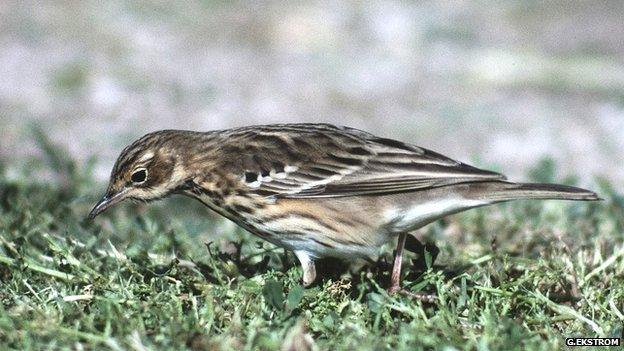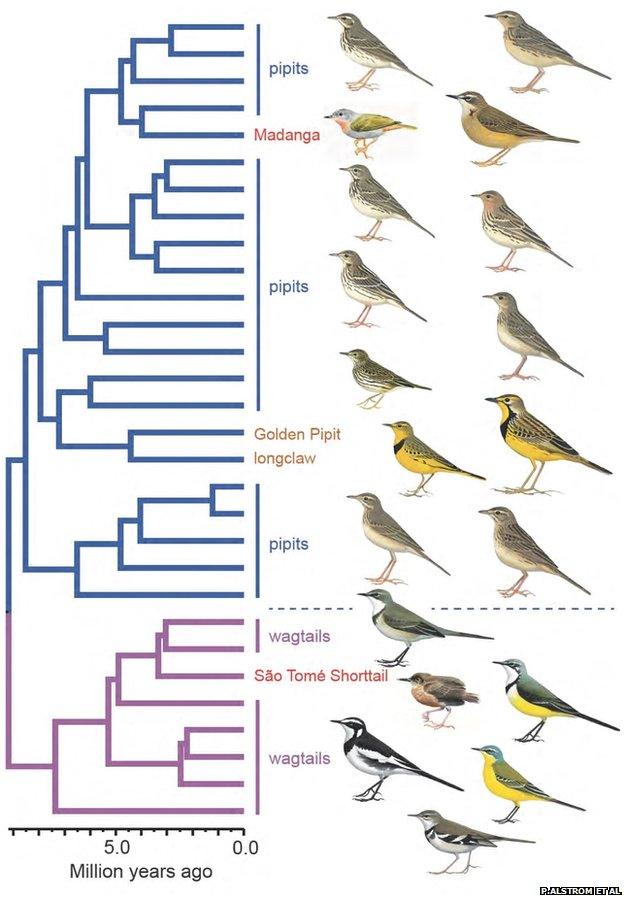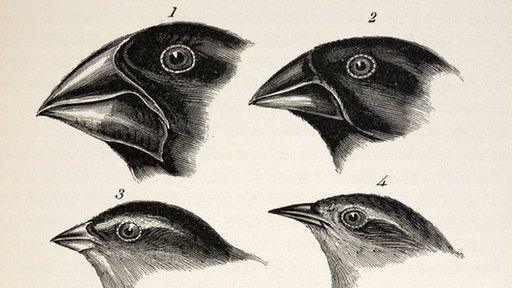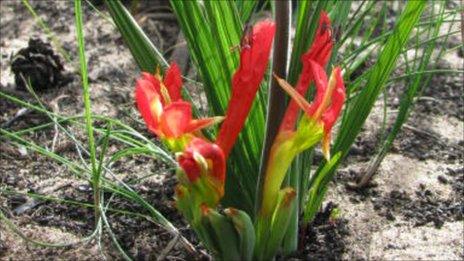DNA reveals bird habitat shift surprise
- Published

Unlike other members of the pipit family, the madanga is a tree-dwelling species
A "dramatic" shift in behaviour and appearance obscured the identity of two birds on remote tropical islands.
The forest-dwelling birds are members of the pipit and wagtail families, but were not recognised as such, partly because they live in very different habitats to their relatives.
The madanga was considered to be a white-eye species, while the Sao Tome shorttail's affinities were uncertain.
The findings appear in the Royal Society journal Open Science, external.
DNA samples confirmed the their true identities, and it suggests that birds can change appearance in short periods of time.
"This is surprising because these birds do not look anything like a pipit or wagtail," explained co-author Per Alstrom from the Swedish Species Information Centre, based at the Swedish University of Agricultural Sciences.
He told BBC News that the birds also occurred in "completely different habitats".
"The madanga (Madanga ruficollis) forages in trees. It probably spends its entire life in trees, moving along branches and tree trunks.
"These trees are heavily covered with epiphytes so - in a sense - the birds are rather ground-like which is one of the reasons I think this species has not had a great deal of difficulty adapting to this new habitat."
Prof Alstrom presumed that the birds' ancestors were long distance migratory species that landed on the islands and became established despite the alien habitat.
"These islands are covered totally by forest, which is a very unfamiliar habitat to pipits and wagtails," he said.
"Although, two of the closest relatives to the madanga are the European tree pipit and the olive-backed pipit, which breed in forested areas. However, they nest on the ground and they feed on the ground."

One of the madanga's closest relatives, the tree pipit, displays very different nesting and feeding behaviour
Prof Alstrom added that the madanga's plumage was very different: "There is no streaking, and it is bright green on the upper parts and dark grey on the other parts. It also has a head pattern that looks nothing like a pipit."
However, he added: "Interestingly though, the structure of the bird is quite similar to the tree pipit and we believe that the ancestor of the madanga was pre-adapted to this new niche it became established within.
"Tree pipits are very good at creeping through dense vegetation on the ground. When they are startled and flushed from the vegetation, they often fly up into a tree and they will sit there or they are able to walk quite effortlessly along bigger branches.
"But they never feed up in the trees so the hypothesis here is that the ancestor of the madanga would come to the island of Buru, Indonesia, which was completely covered in forest, and it might have fed on the ground between the trees but then in would fly up into the canopy when it was scared by something.
"It would have then discovered that there was plenty of food on these epiphyte-covered branches, and as it was pre-adapted to walking along branches etc, it could have probably managed fairly well in that new habitat.
Prof Alstrom said that this would have meant that there was no evolutionary pressure for it to evolve a new structure.
"For example, if you look at the bill, it is a very typical tree pipit bill, and so are the legs and claws. This means the actual shape of the bird has not changed very much.
New life, new look
The decision to look more closely at the birds was a bit of good fortune. Prof Alstrom said one of the study's co-authors felt that the madanga was not a white-eye species of bird because it looked quite different from other white-eye species.
"So we decided to ask for permission to take DNA samples from one of the specimens in the American Museum of Natural History," he recalled.
"We were quite shocked when we realised it was a pipit, so we decided to have a second individual sequenced to see if we got similar results."
Prof Alstrom said the findings seemed to suggest that birds could appear in new habitats and change their appearance relatively quickly.
"I believe it has happened over and over again where birds and other organisms have first changed their habitat, their niche and then subsequently their morphology," he suggested.
"This could have triggered radiations of new life-forms and new groups of organisms."

Relationship of the pipit and wagtail family (Motacillidae), including the madanga and Sao Tome shorttail
- Published11 February 2015

- Published6 September 2011
